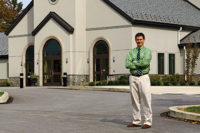The Superdome, the last of the 1970s era massive U.S. domed sports stadiums still in operation, is a major part of New Orleans’ culture.
Now referred to as the Mercedes Benz Superdome (thanks to a 10-year naming rights deal signed in 2011), the 72,308-seat, 52-acre facility broke ground in 1971 after legislation to build it was passed by the largest margin in Louisiana history.
Over the years the Superdome has hosted some of the sporting world’s most famous events. In 1978, Muhammad Ali defeated Leon Spinks before 65,000 fans, while Sugar Ray Leonard beat Roberto Duran in their famous “No Mas” boxing match in 1980.
The facility hosts college football’s annual Sugar Bowl and has been the home to NCAA men’s basketball finals (Michael Jordan hit the game-winning shot as a North Carolina freshman in 1982), rock concerts (The Rolling Stones packed a reported 87,500 fans into the building in 1981) and world dignitaries (Pope John II addressed 80,000 children there in 1987). Nearby Tulane University and Louisiana State University set an NCAA baseball single-game attendance record in the Superdome in 2002 (27,673). In recent times, the Superdome has been the home for three college football BCS championship games. The facility will play host to World Wrestling Entertainment’s 30th Wrestlemania next April.
The domed stadium was at the center of one of the country’s greatest natural disasters, serving in 2006 as a refuge for 30,000 Hurricane Katrina evacuees. The Superdome closed for 13 months after Katrina for major repairs and improvements — the largest stadium reconstruction project ever attempted in the United States.
The facility later underwent an $85 million renovation, which modernized it and added seating, suites and club areas. Since 2006, a total of $336 million has been spent on Superdome renovations, including a new exterior LED lighting system. The lighting system is sustainable and environmentally responsible — a bulb will not need to be replaced for 45 years. The energy it takes to power the lighting system is the same amount used to power a small home.
According to SMG, the building’s management company, by the end of the current New Orleans Saints lease at the Superdome in 2025, every dollar spent on repairs and enhancements will return $58 to the state.
In February, the 37-year-old Superdome made headlines again after a major power outage caused a 33-minute delay in Super Bowl XLVII between the Baltimore Ravens and the San Francisco 49ers. The Superdome has hosted an NFL-record seven Super Bowls.
Some viewers took to social media sites to ask if the power outage put the toilets in the Superdome out of order. The answer is no. During the outage, the Sloan sensor-activated toilets and urinals were operational throughout the stadium. Fans who attended the game can thank a Superdome maintenance supervisor who wisely foresaw the possibility of a power outage and knew about True Mechanical Override, a new flushing technology that keeps sensor-activated flush valves operational during such an incident.
Plumbing renovations
The Superdome reopened in June 2011 upon completion of its last phase of renovations. Sloan plumbing systems were specified with each renovation phase with the last showcasing the latest in the company’s water-efficient technology.
Gonzales, La.-based Superior Products specified Sloan vitreous china urinal and water closet fixtures with sensor-activated flush valves for the restrooms. Metairie, La.-based Gallo Mechanical handled all plumbing and HVAC upgrades and repairs in the dome, which has 125 million sq. ft. of interior space.
“In the past not many engineers or building owners liked the idea of having a fixture from another manufacturer with a Sloan valve because they are not designed to go together,” Superior President Sean Hebert explains. “When they heard Sloan had china, it was met with open arms. They were heavily in favor of going with one manufacturer of china and flush valves.”
For the first phase, the Superdome installed sensor-activated and hardwired Royal 111 ES-S flushometers. Shortly after putting in the plumbing order for the final phase, the maintenance supervisor voiced his concern that a power outage could leave the flush valves unusable, which would create major headaches in a building the size of the Superdome that generally features high-capacity crowds in excess of 60,000.
“He asked if there was a manual override,” Hebert says.
Hebert notes that was about the time his company received a sample of the Sloan’s True Manual Override. He adds the maintenance supervisor took the sample to his boss and “pushed the issue that they should have the TMO.”
The Superdome ended up changing its order from the standard ES-S valves to the new TMO units. The override enables the electronic flush valve to operate manually when there is no power.
Good planning and the proper technology went a long way toward avoiding a major restroom uproar during the much-talked-about Super Bowl power outage.




